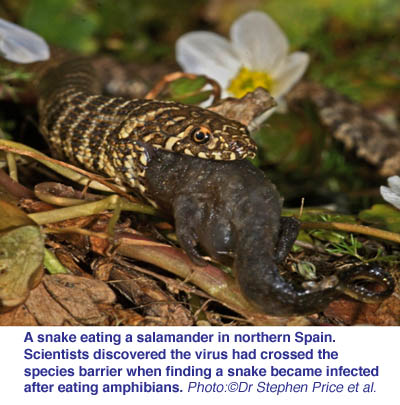 Scientists tracing the real-time impact of viruses in the wild have found that entire amphibian communities are being killed off by closely related viruses introduced to mountainous areas of northern Spain.
Scientists tracing the real-time impact of viruses in the wild have found that entire amphibian communities are being killed off by closely related viruses introduced to mountainous areas of northern Spain.
Researchers in London from UCL, the Zoological Society of London (ZSL), Queen Mary University of London (QMUL), and the National Museum of Natural Sciences (MNCN-CSIC) in Madrid, found the viruses are causing severe disease and mass deaths in many amphibian species sampled, including frogs and salamanders.
The common midwife toad, common toad and alpine newt were the worst affected, showing levels of population collapse which could ultimately prove catastrophic to amphibian communities and their ecosystems.
The results have wider significance as emerging diseases threaten all animal groups, including humans, where viruses have crossed the species barrier from other animals, for instance Ebola, which jumped from bats and other wild animals to humans.
The paper, published this month in Current Biology, reports a remarkable breadth of animals being infected including a snake which had been feeding on infected amphibians.
The viruses are part of the Ranavirus group which has previously been shown to only cause declines in the UK's common frog – so this is the first time a member of the group (Common midwife toad virus or CMTV) has been found to affect entire host communities simultaneously.
From annual surveys across 15 locations in Picos de Europa National Park between 2005 and 2012, the team found animals from six amphibian species, of all ages, dead or dying from infection with CMTV. Through genetic analysis the team found all the viruses causing the infections stemmed from a single source with a near identical genome to the sample of CMTV found in the first infected animal in the Park.
 First author, Dr Stephen Price of UCL's Genetics Institute, who worked across UCL, ZSL and QMUL on the project, said: "One of the main threats to biodiversity is the emergence of infectious diseases that can impact dramatically on entire communities. We've identified a striking example of two viruses that are repeatedly overcoming the species barrier with catastrophic consequences. This presents us with a great opportunity to understand more about the ecology and epidemiology of important multi-host pathogens.
First author, Dr Stephen Price of UCL's Genetics Institute, who worked across UCL, ZSL and QMUL on the project, said: "One of the main threats to biodiversity is the emergence of infectious diseases that can impact dramatically on entire communities. We've identified a striking example of two viruses that are repeatedly overcoming the species barrier with catastrophic consequences. This presents us with a great opportunity to understand more about the ecology and epidemiology of important multi-host pathogens.
"Indications are that related viruses are beginning to emerge in other locations in Europe and it's important to understand the origins and movement of these viruses to try to limit further amphibian declines."
Other examples of pathogens with the rare capacity to simultaneously exploit a variety of new hosts to a similarly catastrophic degree include West Nile virus (infecting birds, humans, ticks, reptiles and amphibians) and white-nose syndrome in North American bats.
The fungus causing white-nose syndrome has led to some six million bat deaths since 2006, with declining numbers of over 90% and the predicted extinction of at least one species of bat. This has left an estimated 1.1 million kg of uneaten insects which are causing crop damage, in turn affecting food supply and prices.
LINK
Article in Current Biology: "Collapse of Amphibian Communities Due to an Introduced Ranavirus"






